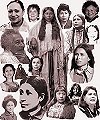 |
Ancient
Voices
A
Museum to honor the least known people in North America,
the Original Tribal Women |
Bead work & Quill work
Bead work
There are different types of creative bead work done by the various tribes, on this site I will try to show as many styles as I can.
Iroquois:
According to the Iroquois world-view, plants are always used in design as vital symbols of all the gifts of the Creator. Thus, most beadwork, both historic and contemporary, repeats motifs essential to the Iroquois cosmology: the Sky World from which a woman fell; the turtle's back upon which she landed; the twins she eventually bore; the plants, animals, birds, trees, water, and wind that inhabit and surround the earth—Turtle Island.
Huichol:
This technique comes for the Natives in Mexico. It is very unique and done by placing the beads into a thin layer of bees wax with their hole facing upward.
The forms used to do this technique are made of wood in the shapes of bowls, sticks, eggs, masks, plaques and carved animal heads. Gourds and other dried vegetables are also used.
Designs on these forms are plants, flowers, geometrical shapes and snowflake shapes.
Penobscot:
"When I look at the floral designs I see plants that ease childbirth, break fevers, soothe coughs and colds, take away pain, heal cuts, burns and bruises, and maintain general health. For thousands of years these plants were used for healing by the tribes in this area. A hundred years ago plants were the main source of medicine for Natives as well as non-natives. With the knowledge and importance of these plants in our culture beadworkers needed to look no further than their own backyards for their own floral designs. A hundred years later these same plants are still in our backyards, are still being used for healing and are still being used to inspire our beadwork designs." —Jennifer Sapiel Neptune
Plateau:
In the 1820s and 1830 French and other European fur traders brought glass beads that were made in Venice, Italy and were known as "pony" beads. It was about this time that fully beaded bags began to appear.
In the 1860s smaller glass beads, known as "seed" beads were imported from Belgium or Czecho-Slovakia.
DESIGNS - early on beaded bags had geometric designs similar to the twined "root" bags - but in time the colorful beads were used to create floral patterns and pictorial motifs which proved to be very popular.
Please click on the links below to see the designs.
|

